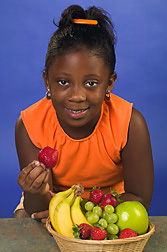This page has been archived and is being provided for reference purposes only. The page is no longer being updated, and therefore, links on the page may be invalid.
|
|
Getting Grade School Kids to Eat More Fruits and Veggies
By Alfredo FloresDecember 21, 2007
One approach frequently suggested as an effective way to increase children's consumption of healthy foods is to encourage them to participate in food preparation activities. Now a study conducted by scientists with the Agricultural Research Service (ARS) Children's Nutrition Research Center (CNRC) in Houston, Texas, has demonstrated that this may be an effective approach.
Karen Cullen, a CNRC behavioral scientist and associate professor of pediatrics at Baylor College of Medicine (BCM), and her colleagues evaluated the impact of combining food preparation and goal setting on 671 fourth-grade students in the Houston area over the course of 10 sessions. The CNRC is operated by BCM in cooperation with Texas Children's Hospital and ARS, the U.S. Department of Agriculture's chief scientific research agency.
For six of the 10 sessions in the program, students selected a fruit, juice or vegetable recipe and set a goal to prepare it at home before the next session. In addition, they set a goal related to eating fruit, juice or vegetables.
The recipes most often prepared were Razzle Dazzle (a fruit juice mix), Royal Slush (a fruit slushy), Wizard's Magic Pocket (a pita pocket with vegetables), Great Shake (a fruit smoothie) and Golden Knight Burrito (a vegetarian burrito). Each time, the students returned parent-signed notes reporting whether they prepared a recipe.
The researchers observed an average increase in consumption of one serving per day of fruit, 100-percent fruit juice, or vegetables, compared to the beginning of the study. Girls and Hispanic students achieved the most recipe-preparation goals.
Achieving fruit-juice and vegetable recipe preparation goals was related to students' eating more fruit and juice or vegetables after the study, but the size and direction of the relationship depended on number of goals achieved and how much the students were consuming at the beginning of the study. Practitioners should be encouraged to include recipe preparation and goal setting in interventions with children.
This study appeared in the June 2007 issue of the International Journal of Behavioral Nutrition and Physical Activity. An Open Access version is available at:
http://www.ijbnpa.org/content/pdf/1479-5868-4-28.pdf

